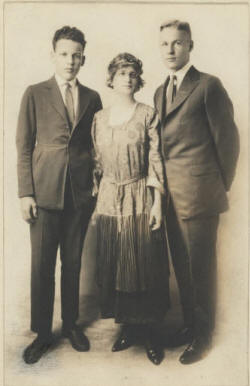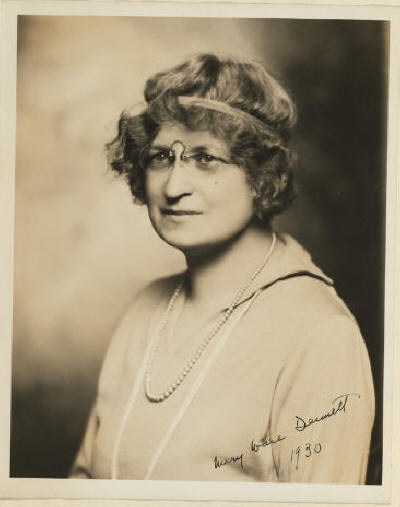

Queer Places:
350 W 55th St, New York, NY 10019
 Mary Ware
Dennett (April
4, 1872 – July 25, 1947) was a suffragist, pacifist, artisan, and advocate of birth control and sex education.
She was a member of the Heterodoxy
Club.
Mary Ware
Dennett (April
4, 1872 – July 25, 1947) was a suffragist, pacifist, artisan, and advocate of birth control and sex education.
She was a member of the Heterodoxy
Club.
Mary Ware Dennett was a founder of the National Birth Control League, director of the Voluntary Parenthood League, and editor of the Birth Control Herald. In 1915 she wrote a pamphlet for her adolescent sons entitled "The Sex Side of Life"; it was banned as obscene by the Post Office, and Dennett was tried and convicted, but the judgement was ultimately overturned amidst nationwide public protest.
Mary Coffin Ware Dennett was born on April 4, 1872, in Worcester, Massachusetts, the first daughter and second of four children of George Whitefield Ware and Livonia Coffin Ames. She was the niece of Edwin Doak Mead and Lucia Ames, two noted Boston social reformers, and the grandniece of Charles Carleton Coffin, historian and war correspondent. When her father, a wool merchant, died in 1882, the family moved to Boston, where she attended public schools before enrolling in Miss Capen's School for Girls in Northampton, Massachusetts.
Influenced in part by the "craftsman ideal" articulated by John Ruskin and William Morris, Dennett chose to study at the school of the Boston Museum of Fine Arts (1891-1893); for several years she won the first prize for tapestry and leather design. After heading the Department of Design and Decoration at Drexel Institute in Philadelphia (1894-1897), she went to Europe with her sister Clara. They collected samples of gilded Cordovan leather wall hangings, were able to revive the lost art, and opened a cooperative handicraft shop in Boston. Dennett helped to organize the Boston Society of Arts and Crafts in 1897 and displayed her leather work in the society's April 1899 exhibition; the Ware sisters' shop soon established an affiliation with the Boston Society of Arts and Crafts, with Dennett serving as artistic decorator for the shop and on the council of the society. She resigned in 1905, however, pointing to the society's increasing interest in "things--their beauty, their sale, their increase...while the primary interest--should be, I think,--the man--his freedom--his economic independence."

In January 1900, Dennett married Hartley Dennett, a Boston architect; they had two sons, Carleton (b.1900) and Devon (b. 1905). At first they worked together, with Dennett as a home decorating consultant, but this ended when Hartley Dennett began an affair with one of his clients, Margaret Chase. He went to live with Chase and her husband, a prominent physician; Dennett successfully sued for divorce and received custody of the children in 1913.
After two years as field secretary of the Massachusetts Woman Suffrage Association, Dennett was elected corresponding secretary of the National American Woman Suffrage Association (NAWSA) in 1910, and moved to New York City. There she was the principal organizer of National American Woman Suffrage Association's literature department, which produced and distributed millions of copies of numerous pamphlets and leaflets, including Dennett's "The Real Point." Embroiled in a dispute over how the department was to be run and financed, and believing that National American Woman Suffrage Association, like many organizations, was showing a "tendency...to petrify and...find themselves actually behind the public opinion which they themselves largely created," Dennett resigned in 1915.
Attracted to organizations seeking a broader redistribution of society's wealth and power, Dennett worked for implementation of the single tax, serving as chair of the Committee on New Voters of the Women's Henry George League, and in the movement for proportional representation. She was an active opponent of the growing war sentiment in the United States, managing a series of mass meetings in the Midwest as field secretary of the American Union Against Militarism, and campaigning for President Wilson's reelection. When the United States entered the war in April 1917, she protested by resigning as executive secretary of the Women's Section of the Democratic National Committee (renamed the League for Progressive Democracy); she became an organizer for the People's Council, a radical antiwar group, and a board member of the Woman's Peace Party. She was also a member of the National Council of the International Free Trade League and a member of the Women's Peace Union.
Dennett is perhaps best known for her work in birth control and sex education. With Jessie Ashley and Clara Gruening Stillman, she founded the National Birth Control League in March 1915. The National Birth Control League repudiated the militant tactics that had forced Margaret Sanger to seek refuge from the law in Europe; it focused on changing state and federal statutes that held that any materials or printed mattter intended for preventing conception were obscene and therefore unmailable. Maintaining that birth control was a "purely scientific topic," the National Birth Control League cultivated the support of prominent men and women, and from 1917 to 1919 lobbied unsuccessfully in the state legislature in Albany to remove contraceptive material from the New York law.
Realizing that it would be most efficient to remove contraception from the federal Comstock law, on which the state laws were based, Dennett in 1919 reorganized the National Birth Control League as the Voluntary Parenthood League, serving as its director and as editor of the Birth Control Herald. The sole purpose of the Voluntary Parenthood League was to remove the words "preventing conception" from the federal law, thereby permitting the free dissemination of information about birth control. In this the Voluntary Parenthood League was opposed by Sanger, who favored amending the law so that contraceptive information could be given out only by physicians. For Dennett, Sanger's approach smacked of special class legislation. In 1925, at the end of her last unsuccessful lobbying campaign in Congress, Dennett wrote Birth Control Laws, an exhaustive analysis of the history and status of federal and state laws governing birth control, hoping to influence public opinion. In the end, neither Sanger's "doctors only" bill nor Dennett's appeal to the "fundamental sound sense of the average American citizen" was successful in changing the law; legal relief came from the bench in the 1930s in the form of a series of decisions circumscribing federal interference with the circulation of contraceptive literature and materials.
One of the factors contributing to the change in the legal climate was a 1930 case involving Dennett's dissemination of a pamphlet entitled "The Sex Side of Life." Written in 1915 for her adolescent sons, this no-nonsense essay explained human reproduction and described the sexual encounter as "a vivifying joy,...a vital art." It was published in 1918 and throughout the 1920s was widely distributed to individuals as well as to youth and church organizations and state health departments. The pamphlet was banned as obscene by the Solicitor of the Post Office in 1922, and in 1928, with evidence secured through the use of a decoy address, Dennett was tried under the Comstock law, convicted, and fined $300. Two years later, in the midst of nationwide public protest, the United States Circuit Court of Appeals court held that the Comstock law "must not be assumed to have been designed to interfere with serious instruction regarding sex matters unless the terms in which the information is conveyed are clearly indecent." The Dennett case was part of a series of decisions that culminated in the 1936 ruling, in United States v. One Package of Japanese Pessaries, that the Comstock law did not "prevent the importation...by mail of things which might...be employed by...physicians." This decision removed all federal bans on birth control materials and information as tools for medical professionals. Contraception was not actually removed from the prohibitions of the Comstock law until 1971.
Her experience in the "Sex Side of Life" case as well as the overt government hostility towards pacifists during World War I heightened Dennett's interest in civil liberties issues. She published Who's Obscene?, an account of the Sex Side of Life trial, in 1930, and was active for many years on the National Council on Freedom from Censorship and with the American Civil Liberties Union.
In 1926 Dennett abandoned her lobbying, resigned as director of the Voluntary Parenthood League, and returned to leather work as "my salvation." She nonetheless continued to follow the progress of birth control legislation through Congress and maintained her interest in sex education for young people, contributing a chapter on the subject to Sex in Civilization (1929), and publishing The Sex Education of Children (1931). She also persisted, as her voluminous correspondence attests, in responding "to all the poor applicants for contraceptive information...[writing them about] the League's inability to break the law, etc.," and "then privately and anonymously" furnishing the needed information.
Despite her work for dozens of causes, Dennett had a "fearful revulsion" against organizations. This anti- institutional bias was philosophical as well as pragmatic, with Dennett, in the tradition of John Dewey, making no claims of moral absolutism. Hers was "a plea for the dynamic, instead of the static side of life..., against anything and everything that tends to institutionalize one's mind." For Dennett, moral law was "subject to evolution like other phases of human development," an evolution in which individual liberty and the "unquenchable aspiration of the human soul" remained paramount.
Dennett died in a nursing home in Valatie, New York, in 1947.
My published books: